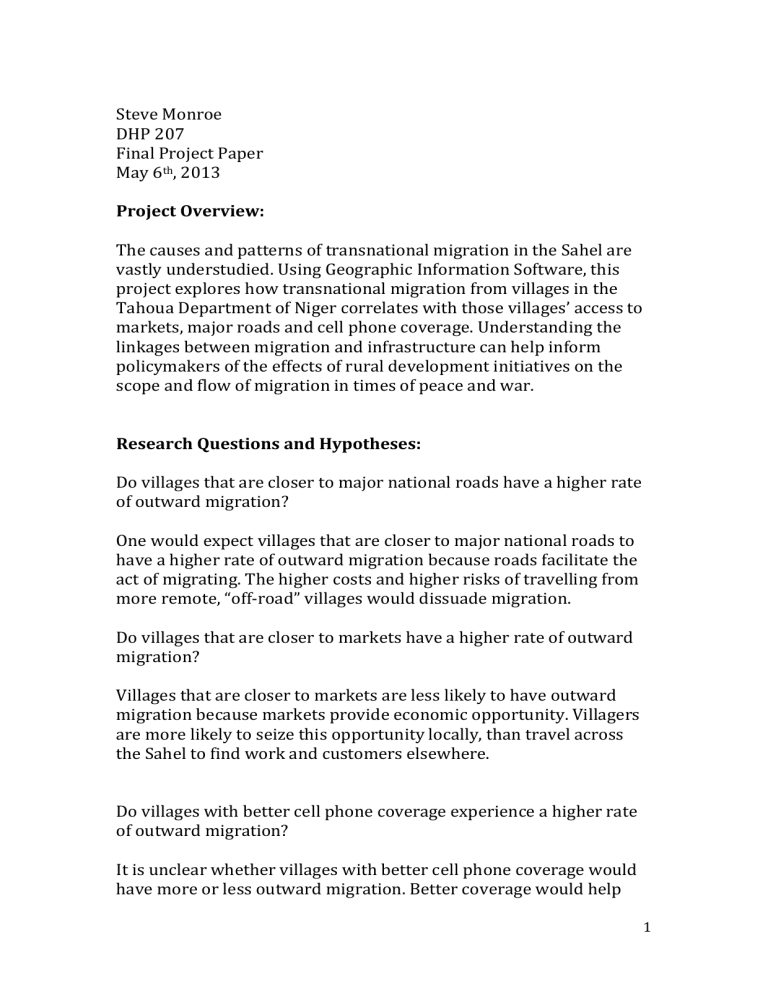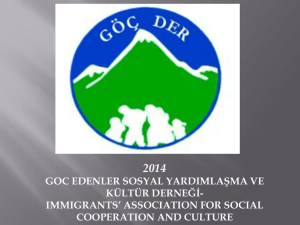Final Project Paper

Steve Monroe
DHP 207
Final Project Paper
May 6 th , 2013
Project Overview:
The causes and patterns of transnational migration in the Sahel are vastly understudied. Using Geographic Information Software, this project explores how transnational migration from villages in the
Tahoua Department of Niger correlates with those villages’ access to markets, major roads and cell phone coverage. Understanding the linkages between migration and infrastructure can help inform policymakers of the effects of rural development initiatives on the scope and flow of migration in times of peace and war.
Research Questions and Hypotheses:
Do villages that are closer to major national roads have a higher rate of outward migration?
One would expect villages that are closer to major national roads to have a higher rate of outward migration because roads facilitate the act of migrating. The higher costs and higher risks of travelling from more remote, “off-road” villages would dissuade migration.
Do villages that are closer to markets have a higher rate of outward migration?
Villages that are closer to markets are less likely to have outward migration because markets provide economic opportunity. Villagers are more likely to seize this opportunity locally, than travel across the Sahel to find work and customers elsewhere.
Do villages with better cell phone coverage experience a higher rate of outward migration?
It is unclear whether villages with better cell phone coverage would have more or less outward migration. Better coverage would help
1
inform villagers of economic opportunities elsewhere. However, cell phone coverage also promotes local economic development by helping farmers connect with markets. This would dissuade migration.
Data:
Data on migration rates, cell phone coverage and market proximity came from Dr. Jenny Aker’s on-going research in Niger and her article
“Zap it to Me: The Short-Term Impacts of a Mobile Cash Transfer
Program,” 2011. Regional Census data was provided by Niger’s
“Annuaire Statistque Des Cinquante Ans D’independance Du Niger,”
2010.
The shapefile on Niger’s National Roads was obtained from the
Humanitarian Response Common and Fundamental Operational
Datasets Registry, http://cod.humanitarianresponse.info/countryregion/niger . The Michael Bauer Research, Environmental Systems
Research Institute (ESRI) published this map in 2011. This vector data is accurate as of 2007. The shapefile on Niger’s Departmental
Boundaries stems from Gfk Marktforschung, http://www.gfkgeomarketing.com/en/digital_maps/niger.html
. This map was published in 2011 and is accurate as of 1996.
Methods:
To test my hypotheses, I first aggregated Professor Aker’s household survey data on to a village level. I then determined each village’s migration rate by dividing the total of reported migrated family members by the total household members surveyed in each village in
May 2011.
Using each village’s longitudinal and latitudinal X – Y coordinates, I plotted their outward migration rates using graduated symbols on to a map of Tahoua. I plotted a layer for markets using Dr. Aker’s X – Y coordinates for Tahoua’s markets. Finally, a layer of Niger’s major roads was added on the map. All data frame properties and layers were projected on to WGS_1984_UTM_Zone_31N, and given a linear unit of 1 meter.
2
I created two raster grids using the Euclidean distance tool for the markets and major roads layers. The market raster was divided into seven gradients of five kilometer intervals. These intervals reflect differences in ease of reaching a market by foot and by car. The major roads raster was divided into eight gradients, with intervals progressively expanding from two, to four, to eight to eleven kilometers. The greater differentiation at earlier intervals highlights differences in reaching a major road by foot and then farther away, by vehicle.
Lastly, a Market – Road accessibility raster was created using the
Raster Calculator tool of the Map Algebra function. I previously reclassified the intervals of the Major Roads and Market rasters assigning new values where the closest gradients were given a one value and each succeeding interval an additional point. The Map
Algebra function simply added to the two raster values together.
Locations with the lowest points are closest to both markets and major roads.
After mapping the data, I applied the Near Tool to calculate each village’s closest distance to a market and major road. These distances were then graphed in relation to migration rates on scatter plots.
Because all data on the strength of cell phone coverage stemmed from surveys, correlation between migration rates and cell phone coverage was also graphed on a scatter plot.
Findings:
This data reveals little correlation between distance away from a major roads and outward migration rate per village. Villages close to major roads had the same variance in migration rate than villages away from roads. Likewise, there also appears to be no correlation between migration rate and proximity to markets.
There does appear to be a correlation between cell phone coverage and village level migration rates. This data reveals that villages with higher reported cell phone coverage have a higher rate of migration.
This suggests that cell phone coverage may promote migration by giving cell phone users in one village more information about opportunities elsewhere, thus leading to more migration.
3
These findings hint that infrastructure development may have countervailing effects on migration. While major roads, markets and cell phone coverage can discourage migration by providing and promoting local economic development, they can also facilitate the act of migrating (roads) and expand migrants’ networks and information about opportunities elsewhere (markets, cell phone coverage). These opposing effects mitigate the impact of infrastructure projects on outward migration.
Lastly, villages in the north eastern part of Tahoua seem to have higher migration rates. Future research should investigate this phenomena.
Challenges:
A major shortcoming of this research is that it only covers transnational migration, not internal migration. This is because the survey questionnaire did not ask about internal migration. Internal migration is just as susceptible to the effects of infrastructure development as transnational migration. Thus, I worry that a lot of the data on potential correlations between infrastructure and migration is missing because internal migration was excluded.
Finding accurate data on Niger’s road construction was another challenge. My road layer is only accurate as of 2007, four years prior to when the survey was carried out. New road construction during that period may skew my findings.
Concluding thoughts:
The absence of any correlation between outward migration and proximity to markets and roads validates the complexity of understanding migration patterns. Future research should include an income component. Proximity is only one factor of access. Ease of access is equally important. Citizens of wealthier villages that are farther away from roads or markets can overcome the challenges of distance with the comfort of vehicles. Likewise, it remains to be seen whether villages with better cell phone coverage are targeted by cell phone companies because they use more cell phones, and are therefore wealthier and thus have the means to migrate if need be.
Ultimately, I think this data on distance from markets and major roads will be most useful in regressions that control for other variables like income and economic activity.
4
Peer-Reviewed Research and Other Influences:
Human Sciences Research Council. (2006). Migration in south and
southern Africa: dynamics and determinants. Cape Town: HSRC Press.
Migration in south and southern Africa provides a useful appendix on how GIS can be used as a tool in migration research, both in terms of mapping the flow and concentration of migrants. In the appendix, the editors highlight how they applied GIS software to assess whether social mobility is the dominant reason for inter-provincial migration in South Africa. Their research found, counter-intuitively, a surprising proportion South Africans actually migrant out of urban, more economically successful provinces and into the periphery. This source was a great primer on the different ways (flow vs. concentration) to map migration patterns.
Van der Geest, K., Vrieling, A., & Dietz, T. (2010). Migration and
Enviroment in Ghana: A Cross-District Analysis of Human Mobility and Vegetation Dynamics. Enviroment and Urbanization, 22(107).
This research analyzes how environmental factors (farming opportunities, environmental degradation) shape internal migration in Ghana. The authors argue that rural population density and thus access to resources has a greater influence on migration flows than the proximity or abundance of that natural resource. This research aggregated household survey data on to a departmental level. Using this data, they produced a useful map of Ghana (112) that highlights both the concentration of migrants per department, as well as arrows indicating the flow of migrants from one department to other. Not surprisingly, the capital Accra had the highest share of migrants.
Though my data is on the village level, I liked how they captured net migration (whether positive or negative) per department using a darkening color scheme in addition to listing the percentage change in parenthesis.
Brown, S. (2003). Spatial Analysis of Socioeconomic Issues: Gender and GIS in Nepal. International Mountain Society, 23(4), 338 – 344.
This study assessed how Nepalese women’s proximity to watersheds, markets and other geographic variables correlates with levels of gender inequality and socioeconomic activity in their household. The
5
authors collected household survey data and mapped socioeconomic indicators (women’s literacy rates, ect) in relation to geographic indicators. One of their maps looks into how distance from markets and roads relates to gender inequality (figures 3 and 4). I am interested in how those two variables relate to village level migration activity. These maps did a good job presenting the survey data – a surveyed house was given a symbol depending on a level of gender inequality. However, because so many households were surveyed, they cluttered the maps, making it hard to process any geographic correlations with household gender inequality.
Aker, J., Boumnijel, R., McClelland, A., & Tierney, N. (2011). Zap It to
Me: The Short-Term Impacts of a Mobile Cash Transfer Program
(Working Paper No. 268). Center for Global Development.
All of my project’s survey data stems from Professor Jenny Aker’s working paper. Dr. Aker wanted to measure the economic impact of mobile money platforms on households and villages in the Tahoua department of Niger. Figure 1 illustrates the location and density of the surveyed villages. This will be a useful guide when I map these villages. Aker’s research also provides information on the three nearest markets to each village.
Maps:
Map 1: Tahoua Department, Niger
6
Map 2: Outward Migration Rates in Tahoua
Map 3: Road Accessibility Map
Map 4: Market Accessibility Map
7
Map 5: Market – Road Accessibility Map
Graph 1: Outward Migration Rate Relative to Distance from Major
Road (M)
8
Graph 2: Outward Migration Rate Relative to Distance from Market
(M)
Graph 3: Outward Migration Rate Relative to Cell Phone Coverage
9
10







